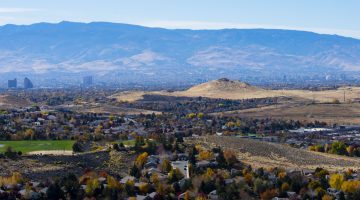
Photo: (CC) Maurizio Pesce/Flickr.com
A Model S is assembled inside Tesla’s factory in Fremont, California on Oct. 1, 2011. The new gigafactory under construction just east of Reno will produce the lithium-ion batteries that will power cars manufactured in the Fremont factory.
By Jacob Solis
Last Wednesday, representatives from Tesla Motors visited the University of Nevada, Reno campus in search of bright, young interns. Just four months prior, the company announced a partnership with Nevada to build a $5 billion gigafactory that could potentially bring hundreds of millions of dollars and thousands of jobs to the state.
With this in mind, a question arises: just how did Tesla, a car company that has sold a grand total of two different models, come to be the largest economic boon to Nevada in recent memory?
Humble beginnings
Prior to 2014, Tesla Motors did not have a single tie to Nevada. The company began in 2003 when a group of Silicon Valley engineers banded together to prove the viability of electric cars as a replacement to the gasoline-powered automobile. What followed this meeting was what may be described as a meteoric rise to prominence in an industry dominated by massive corporations such as Ford, General Motors and Toyota.
Tesla’s ascension through the ranks can be attributed primarily to entrepreneur Elon Musk, who invested tens of millions into the company during its infancy. Musk, who was a co-founder of PayPal and currently helms Tesla as CEO, devised a bold business plan not unlike Henry Ford’s in the early 20th century: prove electric cars can work, sell them to the rich and finally make them cheap enough for everyone to buy.
Musk and his Tesla associates have found tremendous success in the first steps of their plan. Tesla released its first car, the Roadster, in 2008 to modest sales that remained impressive considering the company’s status as a startup. Tesla then took the idea of an electric car one step further with the Roadster’s successor: the Model S, a luxury sedan meant to compete with the likes of Mercedes-Benz, BMW and Lexus.
After going public on the stock exchange in 2010, Tesla found itself with hundreds of millions in its coffers and a massive new factory in Fremont, California. With all the necessary tools at its fingertips, Tesla launched the Model S to widespread acclaim in 2012, selling over 50,000 units by the end of 2014.
The Gigafactory
Even with the success of the Roadster and Model S, Tesla was (and still is) catering to a niche market. Among luxury auto manufacturers, which only comprise 10 percent of the U.S. car market, Tesla controlled less than 3 percent of the market. To achieve its goal of making electric cars for the masses, Tesla needed to take another leap.
Enter the gigafactory: a sprawling 1,000-acre complex that, according to Tesla projections, could theoretically produce 500,000 lithium-ion batteries a year while reducing production costs by 30 percent. Tesla immediately began courting states across the West, attempting to goad the best deal from state lawmakers eager to capture the economic potential the factory offered.
After months of deliberation, Musk made his way to Carson City last October to stand side-by-side with Gov. Brian Sandoval and announce the gigafactory’s arrival in the Silver State.
Why Nevada?
Tesla’s negotiations with states were confidential, so the ultimate reason for the Nevada-Tesla partnership remains unknown. However, what is known is that both parties will receive vast sums of money in the long run.
Over the next 20 years, Tesla will receive $1.3 billion in tax breaks from the state of Nevada. For the same period, Tesla will pay no sales taxes and no property or business taxes over the next decade with an extra $195 million in tax credits thrown in to sweeten the deal.
Moreover, the Nevada gigafactory, set to open in 2017, has provided Tesla with the coveted opportunity to complete its master plan.
“This factory is important to the future of Tesla,” said Musk during the October announcement. “Without it, we cannot produce a mass-market car.”
On the flip side of the deal, Nevada will see an economic boost as high as $100 billion over two decades, according to metrics released by state officials. Gov. Sandoval is especially optimistic regarding the size of new revenues for the state, estimating an increase of nearly $1.4 billion over two decades in a statement released after the announcement.
Additionally, estimates from Tesla and the Governor’s Office have the factory employing 6,500 people and the project as whole bringing in around 22,000 workers. Many parties, including localities, businesses and even UNR, are excited for the deal’s economic benefits and employment prospects.
“The university is experiencing great momentum,” said UNR President Marc Johnson in an interview with the Reno Gazette-Journal. “[UNR] can play a role in welcoming Tesla to this region by providing a broad range of university-trained professionals that will be important to the workforce.”
Even so, not everyone was pleased with the fine print of the deal. When the Nevada Legislature was called into a special session to approve the arrangement, critics from the Nevada Policy Research Institute and the Progressive Leadership Alliance of Nevada were skeptical of Gov. Sandoval’s lofty economic claims. In addition, many others were unhappy that the deal transferred $70 million from an a $80 million film tax fund and worried that the Nevada film industry, especially the Las Vegas industry, could see harm in the near future.
Despite these concerns, the legislature passed the deal and construction of the gigafactory is well underway. Ultimately, many Nevadans, from business owners to lawmakers, are pleased with the deal. The consensus was put succinctly by Gov. Sandoval who, following the announcement, called the deal a victory for Nevada.
Jacob Solis can be reached at jsolis@sagebrush.unr.edu and on Twitter @TheSagebrush











